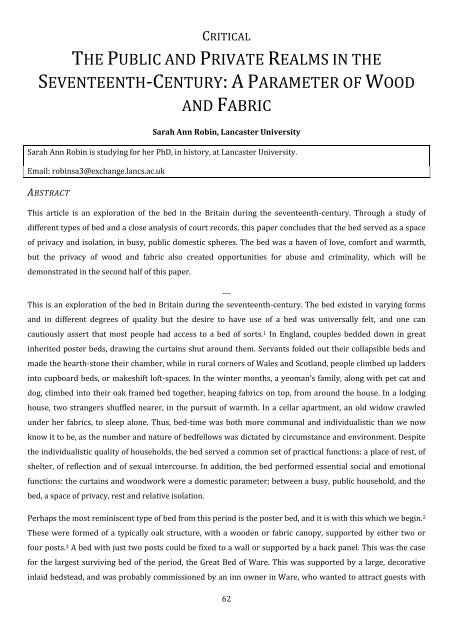download this issue as a PDF
download this issue as a PDF
download this issue as a PDF
You also want an ePaper? Increase the reach of your titles
YUMPU automatically turns print PDFs into web optimized ePapers that Google loves.
CRITICAL<br />
THE PUBLIC AND PRIVATE REALMS IN THE<br />
SEVENTEENTH-CENTURY: A PARAMETER OF WOOD<br />
AND FABRIC<br />
Sarah Ann Robin, Lanc<strong>as</strong>ter University<br />
Sarah Ann Robin is studying for her PhD, in history, at Lanc<strong>as</strong>ter University.<br />
Email: robinsa3@exchange.lancs.ac.uk<br />
ABSTRACT<br />
This article is an exploration of the bed in the Britain during the seventeenth-century. Through a study of<br />
different types of bed and a close analysis of court records, <strong>this</strong> paper concludes that the bed served <strong>as</strong> a space<br />
of privacy and isolation, in busy, public domestic spheres. The bed w<strong>as</strong> a haven of love, comfort and warmth,<br />
but the privacy of wood and fabric also created opportunities for abuse and criminality, which will be<br />
demonstrated in the second half of <strong>this</strong> paper.<br />
---<br />
This is an exploration of the bed in Britain during the seventeenth-century. The bed existed in varying forms<br />
and in different degrees of quality but the desire to have use of a bed w<strong>as</strong> universally felt, and one can<br />
cautiously <strong>as</strong>sert that most people had access to a bed of sorts. 1 In England, couples bedded down in great<br />
inherited poster beds, drawing the curtains shut around them. Servants folded out their collapsible beds and<br />
made the hearth-stone their chamber, while in rural corners of Wales and Scotland, people climbed up ladders<br />
into cupboard beds, or makeshift loft-spaces. In the winter months, a yeoman’s family, along with pet cat and<br />
dog, climbed into their oak framed bed together, heaping fabrics on top, from around the house. In a lodging<br />
house, two strangers shuffled nearer, in the pursuit of warmth. In a cellar apartment, an old widow crawled<br />
under her fabrics, to sleep alone. Thus, bed-time w<strong>as</strong> both more communal and individualistic than we now<br />
know it to be, <strong>as</strong> the number and nature of bedfellows w<strong>as</strong> dictated by circumstance and environment. Despite<br />
the individualistic quality of households, the bed served a common set of practical functions: a place of rest, of<br />
shelter, of reflection and of sexual intercourse. In addition, the bed performed essential social and emotional<br />
functions: the curtains and woodwork were a domestic parameter; between a busy, public household, and the<br />
bed, a space of privacy, rest and relative isolation.<br />
Perhaps the most reminiscent type of bed from <strong>this</strong> period is the poster bed, and it is with <strong>this</strong> which we begin. 2<br />
These were formed of a typically oak structure, with a wooden or fabric canopy, supported by either two or<br />
four posts. 3 A bed with just two posts could be fixed to a wall or supported by a back panel. This w<strong>as</strong> the c<strong>as</strong>e<br />
for the largest surviving bed of the period, the Great Bed of Ware. This w<strong>as</strong> supported by a large, decorative<br />
inlaid bedstead, and w<strong>as</strong> probably commissioned by an inn owner in Ware, who wanted to attract guests with<br />
62
















